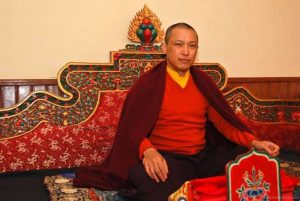
Buddhism and Buddhist rituals, established in Mongolia for nearly 200 years, were wiped out by a Russian regime that ruled from 1921 until 1970. While Mongolia gained a Western-style opera house and ballet company thanks to Russia, their indigenous tradition of Buddhism was decimated and has never fully recovered.
Several international explorer-ethnographers and artists, however, made remarkable visual documentations of Mongolian Buddhist monastic tsam (the Mongolian variant of the Tibetan word cham), among them: Russian Nicholas Roerich (1874–1947) Swede Sven Hedin (1885–1952), German Werner Forman (1922–2010), and Mongol painter Urjingiin Yadamsuren,(1905–87). After 1930 in Mongolia, tsam was never performed again as an unbroken initiated tradition in the region of Urga—the traditional and historical name of Ulaanbaatar, the capital of Mongolia—where Roerich lived for half a year from September 1926 until April 1927. As a Russian, Roerich had the freedom to move around Mongolia during the 1920s, witnessing this large danced ritual that was once common in Tibet, Mongolia, and Buryatia.
Roerich was an artist, an archeologist, a lawyer, a Theosophist seeking wisdom, and an advocate of Russian symbolist art—a movement steeped in spiritual intent and mystical implication. Roerich was interested in some of the same things as Freud and Rasputin: hypnosis, séance, altered states, and trance. In his time, Roerich was a fierce protector of culture, especially during and after war. He was a cultural preservationist. Today Roerich is best known as an artist, whose paintings have transcended their origin and era to become radiant examples of an individual painting style that captured moments of mysticism and beauty throughout Roerich’s own spiritual travels through the Himalaya and beyond. His work continues to speak to new generations through its unique style, content, and intent.
Theosophists and others of Roerich’s generation have been criticized for being overly romantic and for idealizing Asian spiritual traditions. These are merely petty criticisms of what was, in some cases, the driving force behind these extraordinary individuals, who left excellent records for the world. There are indeed wise masters of ancient traditions in Asia. In fact, there are plenty of wise masters on cliffs—this is not an invented trope; I can share a number of stories about meeting spiritual masters on cliffs. Someday, I will.
These cheap shots from modern critics who cannot fathom the types of experiences that people like Roerich had, are attacking the character and intentions of cultural pioneers and are becoming rightly passé: they do not account for humanity, and fail as lenses through which to understand historical behavior. Roerich was interested in initiate mystery traditions, whether Egyptian, Tibetan, or Ancient Greek. Indeed, he identified and located some of these traditions in his travels, learning that tantric Buddhism is absolutely based on initiate transmission and secret mysteries. Roerich’s relevance has already outlived his critics.
Roerich aspired to express this sacredness in his art, not to expose it, reveal it, explain it, define it, or use it to advance an academic career. He shows the massive fabric set up on wooden structures to defy the landscape and weather; his painting shows the elaborate mandala drawn on the ground, guiding the ritual. His painting shows dancers in utmost seriousness and concentration, animating the whole inter-dimensional experience, which at that time included advanced mystical visualizations while collectively performing dances.
Roerich painted the initiate mystery rituals, not their explanation. This is not at all a fanciful connection that he made between ancient mystery practices. Contemporary research in China since the 1980s has shown that many extant exorcistic practices, including Tibetan Buddhist cham, derive from very ancient rituals of blessing for long life and well-being, understood as a subject called Wu Nuo: exorcism by dancing masked shaman. In fact, Roerich’s intuitions were spot on. He was right: this Mongolian tsam was indeed an example of an ancient mystery rite for initiates. He is the only person on earth known to have made a record of this danced ritual.
The painting Mongol Tsam was created in Darjeeling in 1928. It was painted from memory and using sketches. The thangkas in the painting are most likely not by Roerich but by a Tibetan monastic thangka painter. This indicates clearly that Buddhist monks supported his work and even participated in it. Without Roerich’s painting, there would be no record of this dance, nor this unique Mongolian nomadic way of staging the dances—in wide open spaces and with temporary scaffoldings to support enormous, embroidered icons.
The main Tibetan Buddhist deities of longevity and long life are represented in this danced religious rite: Amitayus, the Buddha of Eternal Life; White Tara, a motherly female deity, and Usnisavijaya, the multi-armed protective deity on the right of the main Buddha. An endless row of monks can be seen subtly at the base of the embroideries. Observers appear in shadow outline, wearing traditional clothing. Initiated monk dancers encircle the active meditation field of the detailed, colorful mandala on the ground.
At present, the painting’s whereabouts are uncertain. Sometime in 2017, it was in the custody of Russian police as part of a money-laundering case. I saw the painting in Ulaanbaatar in 2012. It is astonishing and beautiful, and the only link we have as to how tsam was once performed in old Urga.

See more
Related features from BDG
Dance Survival
Dance as Knowledge, Part One
Mongolia: A Complex Dance Survival












